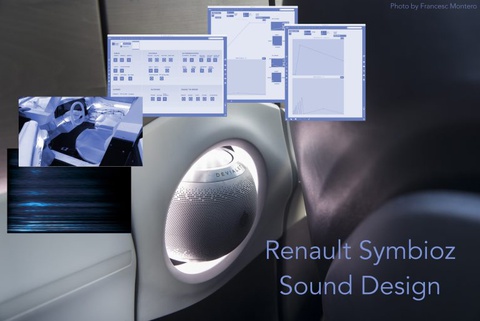En concevant le design sonore de la Renault Symbioz, le nouveau concept car de Renault, un véhicule électrique et autonome, l’équipe Perception et design sonores de l’Ircam a répondu à deux challenges : la conception d’un son de signalétique avertissant les piétons de la présence du véhicule, et la conception d’une gamme de sons destinés à l’habitacle de la voiture.
 Lors de l’édition 2017 du Salon de l’Automobile à Francfort, Renault dévoile sa vision pour 2030 : elle s’incarne dans le concept car Symbioz. Le constructeur offre même aux journalistes l’opportunité de l’essayer.
Lors de l’édition 2017 du Salon de l’Automobile à Francfort, Renault dévoile sa vision pour 2030 : elle s’incarne dans le concept car Symbioz. Le constructeur offre même aux journalistes l’opportunité de l’essayer.
En amont, une collaboration industrielle est initiée pour mettre au point la signature sonore du véhicule, entre les laboratoires de Design et innovation de Renault et l’équipe Perception et design sonores de l’Ircam, représentée par l’ingénieur-chercheur Nicolas Misdariis et le compositeur Andrea Cera.
La Renault Symbioz est la promesse d’une fusion entre véhicule et espace de vie. Le projet porte une attention toute particulière au confort et à la quiétude du passager, ainsi qu’à l’expérimentation des nouvelles technologies pour le contrôle du comportement de la voiture et l’ambiance à l’intérieur du cockpit. Il comporte deux challenges : la conception d’un son externe qui avertit les piétons de la présence du véhicule (la signature sonore), et la conception d’une gamme de sons destinés à l’habitacle de la voiture (les sons du cockpit).
La signature sonore est activée lorsque la vitesse de la voiture se situe entre 0 et 30 km/h –, une plage de vitesse durant laquelle la voiture électrique est potentiellement silencieuse. Ses caractéristiques sont issues de deux projets précédents élaborés par la même équipe : la signature sonore de la Renault Trezor (un concept car) et de la Renault Zoé (un modèle commercialisé).
La signature sonore de la Symbioz est un hybride entre composants électriques et turbine, avec une touche de moteur à combustion, puissante sans être agressive. Quand le moteur est au ralenti, il émet de courtes séquences sonores à la fois douces et aigues créant ainsi un langage abstrait (résultant de l’émergence d’éléments appelés « agents audio ») et avertissant les piétons que le moteur est allumé. Le prototype du son est créé dans le logiciel Max puis convertit dans un environnement propriétaire.
La Symbioz est également un vrai laboratoire d’étude pour les sons de cockpit du futur. L’Ircam a développé un ensemble d’interfaces sonores homme-machine innovantes (IHM) dans deux directions distinctes :
1. Exhaustivité
C’est la totalité des interactions conducteur/passager/cockpit, liées aux modes de fonctionnement de la Symbioz, qui a été traitée.
A ce titre, la possibilité d’un mode de conduite autonome implique de nouveaux challenges au niveau du design : comment communiquer les différents niveaux d’autonomie de la voiture ? Comment rassurer les passagers lorsque la voiture est en mode de conduite autonome ? Pour y répondre, un prototype dans Max a été crée afin de gérer le grand nombre d’IHM nécessaires à la réalisation du projet.
2. Spatialisation
Un concept original d’IHM sonores spatialisées ont été développées.
Chaque son émis dans le cockpit de la Symbioz (clignotants, alarmes, sons informatifs...) est positionné dans un espace acoustique virtuel. La voiture dispose de trois modes de conduite (Classique, Dynamique, Autonome). Dans chaque mode, les sons tournent légèrement autour de positions virtuelles, avec divers degrés de modulation et de réverbération. Par exemple, dans le mode Dynamique, les clignotants sont placés de façon très stable dans la direction que la voiture va emprunter. Dans le mode Autonome, l’orientation des clignotants est beaucoup plus souple puisque qu’aucun passager ne se concentre sur la conduite. En bougeant dans l’espace, les IHMs deviennent moins gênantes et plus naturelles – les changements de position se traduisent par de subtiles altérations de timbre dûes au déphasage et à la réverbération sur les murs du cockpit.








